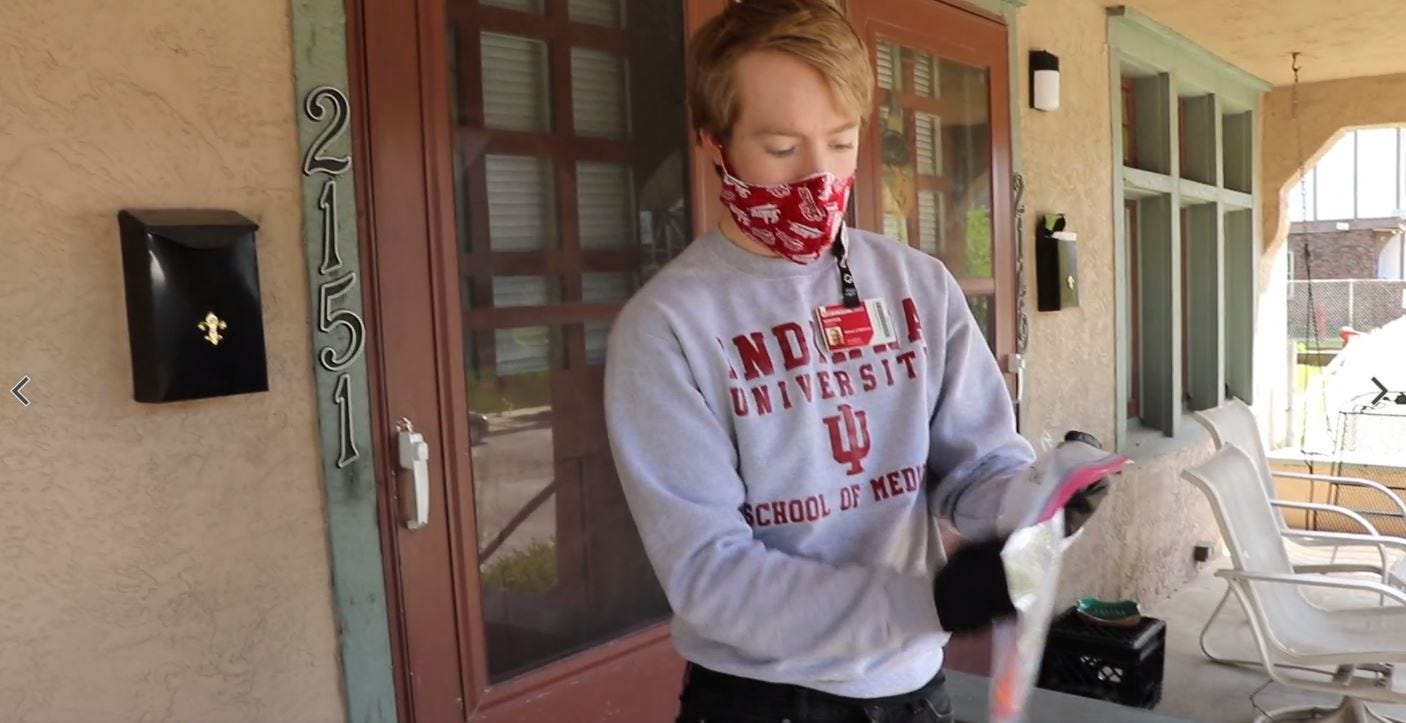Asymptomatic Study to Answer ‘What About the Kids?’
 IUSM volunteers went door to door and waited outside while families used at-home nasal swab testing kits to provide samples.
IUSM volunteers went door to door and waited outside while families used at-home nasal swab testing kits to provide samples.
Subscriber Benefit
As a subscriber you can listen to articles at work, in the car, or while you work out. Subscribe NowThe list of unknowns for the coronavirus has incited fear and frustration for the public and puzzled scientists. One of the biggest concerns centers on large numbers of people who aren’t showing symptoms spreading the virus, and furthermore, much speculation surrounds children being a significant source of that asymptomatic spread. But does science support these theories? Two Indiana University School of Medicine physician scientists are wrapping up a study—the first that includes kids—to help answer those questions, so leaders can avoid making “decisions in the dark.”
“Determining if a lot of COVID-19 is being transmitted by asymptomatic infection is key in figuring out what control strategy we should use,” says Dr. Chandy John, director of the Ryan White Center for Pediatric Infectious Disease and Global Health at IUSM. “There hasn’t been a study so far in the U.S. on this—up to the point we designed and started this study. This fundamental, really seemingly obvious piece of knowledge wasn’t known; how many people in the U.S. are out there walking around with SARS-CoV-2 and don’t know it?”
Co-led by IUSM physician scientist Dr. James Wood, the TACTIC study (Tracking Asymptomatic COVID-19 Through Indianapolis Communities) is sampling 500 volunteers in Marion County to determine how many people who aren’t showing symptoms have COVID-19. And the kicker—and inspiration for the study: it includes children.
“The impetus for our study is this very thing: study [COVID-19] in kids, because so many of the big studies are exclusively in adults,” says John. “What happens with kids is one of the most important things in this outbreak, because it’s simply not possible to sustain what’s happening now [with school and childcare]. But if we don’t have data, we just make decisions in the dark that may not be good for kids or adults.”
Because children are historically a neglected population for research—which John says “is very bad for their health”—including kids in studies has been his career mantra, but the pandemic exposed the inequity even more. Data shows that there are much lower rates of COVID-19 in children, but John says “the speculation [is]…they’re not having symptoms, and they’re running around spreading it.” Early studies point to children as a major source of asymptomatic spread, while more recent research suggests kids have less asymptomatic infections.
“It’s important to know which is the case here in Indiana. There are studies outside the U.S….suggesting [children] are less likely to be infected, but we haven’t had the data in the U.S.,” says John. “Knowing rates of infection in children is important in figuring out how we deal with the issues that surround children like going to school, childcare and contact with older individuals.”
IUSM study leaders expect to detect a very low number of people with COVID-19 who are asymptomatic. Studies in Italy and Iceland found very low rates, with prevalence of asymptomatic cases ranging from 1% to 2%. A second study to determine the community prevalence of SARS-CoV-2 in people who are asymptomatic is also underway at Indianapolis-based Eli Lilly and Company; it aims to include 3,000 participants over the age of 18 in central Indiana.
While the IUSM study is smaller in sample size and geographically than an ongoing Indiana State Department of Health study, it will give decision makers their first clear picture of COVID-19 in children, as the ISDH study doesn’t include anyone under the age of 12. John says each study will inform the other, and he believes the IUSM research can be translated to other communities.
“Information on the prevalence of asymptomatic infection is going to be very useful for any community in the U.S. that’s struck with COVID-19,” says John. “Their prevalence rates may be different, but having an estimate will be very useful in seeing if there’s any difference in adults or kids.”
While costs limit the number of participants to 500, response was so enormous that the study reached its capacity within the first day. Hoosiers who are enrolled in the Indiana Clinical and Translational Sciences Institute’s All IN for Health program who live in Marion County were asked to participate. IUSM volunteers visited participating households and waited outside while families used at-home nasal swab testing kits to provide samples. Findings from the study will be announced in early June.
“[The results are showing] a lot of negatives. That’s what we expected, and that’s what we’re finding so far,” says John. “The community has invested so much in this, we need to get the results to the community as fast as we can.”
John says IUSM plans to launch a follow-up study that will use antibody testing to fine tune the detection of asymptomatic infections.
John says the study reached its enrollment max of 500 within one day, and thousands more expressed interest in being part of the research.
